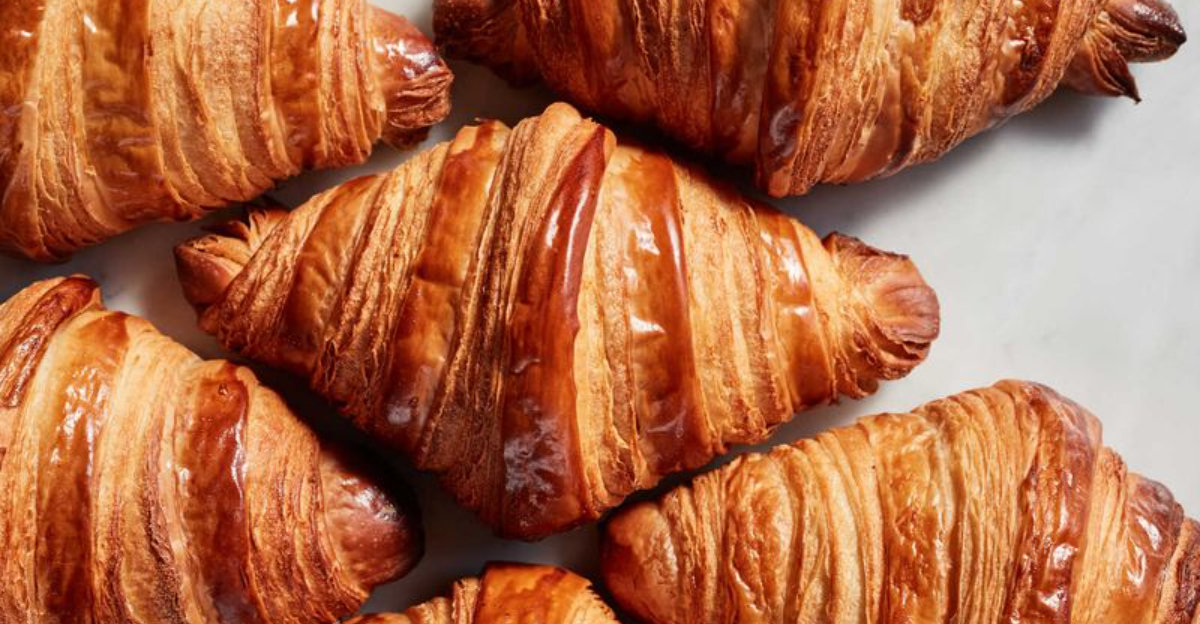9 Breads To Avoid And 9 Better Options Dietitians Recommend

Bread is a staple for many, but not all loaves are created equal.
Some hide sneaky ingredients that might leave you feeling less than great, while others bring wholesome goodness that fuels your body right.
If you’ve ever wondered which breads are worth your calories and which ones to skip, this tasty showdown reveals the choices dietitians love and the ones they advise leaving on the shelf.
1. White Sandwich Bread: The Fluffy Deceiver
Remember those cloud-like sandwiches mom packed in your lunchbox? While nostalgically delicious, white bread undergoes extensive processing that strips away fiber, vitamins, and minerals from the wheat.
The result? A high-glycemic food that spikes blood sugar faster than you can say “PB&J.” Your body digests it quickly, leaving you hungry again before your next class period ends.
Plus, manufacturers often add extra sugar and preservatives to extend shelf life and enhance flavor, creating a nutritional wasteland disguised as a sandwich foundation.
2. Potato Bread: Carb Overload
Golden and slightly sweet, potato bread tempts with its moist texture and comfort-food appeal.
But nutritionally speaking? It’s essentially a carbohydrate double-whammy – combining refined flour with potato starch.
Many commercial versions contain minimal actual potato, instead relying on potato flour or flakes mixed with white flour. This combination creates a higher calorie bread with little nutritional payoff.
The glycemic impact rivals regular white bread, causing the same blood sugar rollercoaster that leaves you craving more carbs shortly after eating.
3. Croissants: Buttery Breakfast Bombs
Flaky, buttery layers that shatter delicately with each bite – croissants are practically edible architecture!
Behind that golden exterior lurks a nutrition reality check: each croissant contains about 50% butter by weight.
A single medium croissant packs roughly 270 calories and 14 grams of fat (mostly saturated), with virtually no fiber or protein to slow digestion.
They’re essentially butter delivery vehicles designed to disappear quickly from your plate – and your hunger satisfaction. The refined white flour base further compounds their minimal nutritional value.
4. Brioche: The Dessert Disguised as Bread
Gorgeously golden with a pillowy interior, brioche seduces with its rich, almost cake-like texture.
The French weren’t kidding around when they created this indulgence – traditional recipes call for eggs, butter, and sugar in quantities that would make a nutritionist wince.
A typical slice contains nearly three times the fat of regular bread and significantly more sugar.
Its richness comes at a nutritional cost: minimal fiber, excessive refined carbohydrates, and a calorie count closer to dessert than bread.
Save brioche for special occasions rather than making it your sandwich foundation.
5. Raisin Bread: Fruity Sugar Trap
Cinnamon-scented and studded with wrinkled gems of sweetness, raisin bread might seem like a healthier choice. Surprise!
Most commercial versions are built on refined white flour with added sugar in the dough – before they even add the raisins.
Those little dried fruits concentrate natural sugars, bumping the total sugar content to impressive heights. A typical slice contains 3-4 teaspoons of sugar between the added sweeteners and raisins.
While raisins do offer some nutrients and fiber, they’re not enough to offset the refined carbohydrate base and sugar overload.
6. Texas Toast: Supersized Trouble
Everything’s bigger in Texas – including the nutritional concerns with this bread! Those thick-cut slices pack nearly twice the calories and carbs of regular bread simply through their jumbo proportions.
Most varieties are made from refined white flour with added sugar, and the pre-packaged garlic versions feature a generous slathering of butter or margarine.
A single slice can contain up to 7 grams of fat and 150 calories before you’ve added a single sandwich filling. The supersized slices also mean supersized impact on blood sugar levels.
7. Refined Ciabatta: The Trendy Troublemaker
With its rustic appearance and chewy texture, ciabatta conquered sandwich menus everywhere.
Unfortunately, most commercial versions are crafted from refined white flour, offering minimal nutritional benefits despite their artisanal appearance.
The signature large air pockets might make for great sandwich structure, but they also mean you’re getting less actual bread per slice – leading many people to consume larger portions.
Most ciabatta lacks significant fiber or protein to offset its refined carbohydrate content. The crispy crust and tender interior come at the cost of rapid digestion and minimal staying power.
8. Refined Flour Bagels: Doughy Dietary Disasters
Dense, chewy, and satisfyingly substantial – bagels have conquered breakfast tables nationwide.
But their heft comes with consequences: a typical plain bagel equals 3-4 slices of bread in carbohydrate content! Most commercial bagels are made from refined white flour stripped of fiber and nutrients.
Their compact nature means more flour per bite compared to fluffier breads. Many varieties also contain added sugars and preservatives to extend shelf life.
Even before adding cream cheese, a single bagel can provide nearly a quarter of your daily calorie needs with minimal nutritional benefits.
9. Pre-packaged Garlic Bread: Flavor at a Cost
That irresistible aroma wafting from the oven masks a nutritional nightmare.
Pre-packaged garlic bread typically combines white bread with a generous slathering of margarine or butter-flavored oil blends containing trans fats or highly processed oils.
The ingredient list often includes artificial flavors, preservatives, and excessive sodium. A typical serving packs around 150 calories and 7 grams of fat – before you’ve even started your meal!
The convenience comes with a hefty nutritional price tag that your body pays long after the garlicky flavor fades.
10. 100% Whole Wheat Bread: The Complete Package
Unlike its paler cousin, genuine 100% whole wheat bread keeps all three parts of the wheat kernel – bran, germ, and endosperm – intact.
This preservation act maintains the grain’s natural fiber, vitamins, minerals, and antioxidants.
The fiber content (around 3-4 grams per slice) slows digestion, preventing blood sugar spikes and keeping hunger at bay longer.
Look for versions listing “whole wheat flour” as the first ingredient with no added sugars. That slightly nutty flavor and denser texture? That’s what real nutrition tastes like!
11. Sprouted Grain Bread: Living Nutrition
Sprouted grain bread begins with an agricultural magic trick – allowing grains to germinate before baking.
This sprouting process increases vitamin content, makes minerals more bioavailable, and decreases antinutrients that can interfere with digestion.
The result? A more digestible bread with higher protein content than regular wheat varieties. Many people with mild wheat sensitivities find sprouted breads easier to tolerate.
The slightly sweet, nutty flavor comes naturally from the sprouting process, not added sugars – a nutritional bonus in every chewy bite.
12. Whole Grain Sourdough: Fermentation Sensation
Sourdough’s signature tang comes from a fascinating fermentation process using wild yeast and beneficial bacteria.
When made with whole grains, this ancient bread-making method creates a nutritional powerhouse.
The fermentation partially breaks down gluten and phytic acid, making nutrients more accessible and the bread more digestible.
Studies show sourdough causes less dramatic blood sugar spikes than conventional breads.
The probiotics created during fermentation support gut health – making whole grain sourdough one of the few breads that actually contributes to your microbiome wellness!
13. Rye Bread: Scandinavian Superfood
Dark, dense, and distinctively flavored, traditional rye bread has sustained Northern Europeans through harsh winters for centuries.
Its secret? Rye contains unique fiber compounds called pentosans that create exceptional fullness and slow digestion dramatically.
Real rye bread (look for “whole rye flour” as the first ingredient) has a lower glycemic index than most other breads.
Studies show rye bread keeps blood sugar levels steadier and hunger at bay longer than even whole wheat varieties.
The robust flavor pairs perfectly with savory toppings while the fiber content supports digestive health.
14. Ezekiel Bread: Biblical Inspiration, Modern Nutrition
Named after a biblical verse describing a bread made from six grains and legumes, Ezekiel bread combines sprouted wheat, barley, millet, lentils, soybeans, and spelt.
This diverse ingredient list creates a complete protein containing all nine essential amino acids – rare for plant-based foods!
The sprouting process increases nutrient availability while reducing antinutrients. Most varieties contain zero added sugars, preservatives, or oils.
With approximately 4 grams of protein and 3 grams of fiber per slice, Ezekiel bread provides slow-burning energy that keeps hunger at bay for hours.
15. Oat Bread: Heart-Healthy Champion
Oat bread’s slightly sweet, nutty flavor comes with impressive heart health credentials.
Made primarily from oat flour or whole oats mixed with whole wheat, it contains beta-glucan – a soluble fiber scientifically proven to lower cholesterol levels.
The American Heart Association recognizes oats as heart-protective due to their ability to reduce LDL (bad) cholesterol. Quality oat bread provides steady energy without dramatic blood sugar fluctuations.
Check labels carefully though – authentic versions list oats or oat flour among the first ingredients and contain minimal added sugars.
16. Multigrain Bread: Diversity in Every Bite
True multigrain bread combines various whole grains like wheat, barley, oats, millet, and flax – creating a nutritional symphony greater than its individual parts.
Each grain contributes unique vitamins, minerals, and phytonutrients for comprehensive nutrition.
The varied fiber types support diverse gut bacteria, promoting microbiome health. Quality versions contain visible seeds and grain pieces rather than just brown-tinted refined flour.
Read labels carefully – authentic multigrain bread lists multiple whole grains before any refined flours and contains minimal added sweeteners or artificial ingredients.
17. Flaxseed Bread: Omega-3 Powerhouse
Speckled with tiny brown seeds, flaxseed bread brings impressive nutritional credentials to your sandwich.
Those little flecks contain alpha-linolenic acid (ALA) – a plant-based omega-3 fatty acid linked to reduced inflammation and improved heart health.
Flaxseeds also provide lignans, unique plant compounds with antioxidant properties that may help balance hormones.
The high fiber content (both soluble and insoluble) supports digestive health and creates lasting fullness.
Quality versions combine flaxseeds with whole grains rather than refined flour for maximum nutritional impact.
18. Gluten-Free Whole Grain Bread: Inclusive Nutrition
Gone are the days when gluten-free meant nutritional compromise! Modern gluten-free whole grain breads combine amaranth, buckwheat, millet, quinoa, and brown rice – ancient grains packed with protein, fiber, and micronutrients.
Many varieties now include psyllium husk or ground flaxseed to mimic gluten’s binding properties while adding beneficial fiber.
The best versions avoid excessive starches and gums that can spike blood sugar.
Always check labels – quality gluten-free bread lists whole grains as primary ingredients rather than refined starches and contains minimal added sugars.
